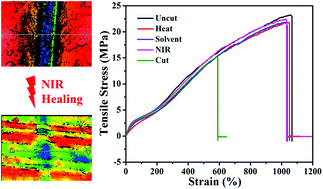Multi-stimuli-responsive self-healing metallo-supramolecular polymer nanocomposites†
Abstract
The self-healing capability is particularly desirable for multifunctional polymeric materials because it can make the materials more reliable, reduce repair costs, and extend their lifetime in many applications. Herein, a multi-stimuli responsive self-healing metallo-supramolecular polymer nanocomposite exhibiting superior mechanical properties was developed and demonstrated. Terpyridine ligand-terminated polyurethane (PU) was prepared by in situ polymerization on the surface of multi-walled carbon nanotubes (CNTs). The terpyridine ligand-terminated CNT/PU prepolymers were dynamically crosslinked with the metal ion Zn2+ to obtain a metallo-supramolecular polymer nanocomposite. The tensile strength and tensile strain-at-break of the CNT/PU polymer nanocomposite increased from 14.2 MPa and 620% to 22.8 MPa and 1076%, respectively, with the addition of Zn2+. The Zn2+-coordinated metallo-supramolecular polymer nanocomposite showed a rare combination of strong, tough, and elastic mechanical properties and was able to self-heal via multiple stimuli, including remotely controlled near infrared (NIR) light (4.2 mW mm−2, 30 min), relatively low temperatures (90 °C, 1 h), and/or solvents, all with excellent healing efficiencies (i.e., higher than 93%) and short healing times. Therefore, this unique multi-stimuli responsive self-healing metallo-supramolecular polymer nanocomposite has the potential to provide advances in structural component, microelectronic and sporting equipment applications, to name just a few.


 Please wait while we load your content...
Please wait while we load your content...